
CATCH AND SPEAR FISH

Spearing fish can be a challenge and fun. To successfully spear one it depends on the width + depth of the water + the size of the fish you're trying to spear + the type of spear head + your patience & throwing skills = a fish meal.
But first let me tell you a story about a fella who goes by the name of "Buckshot." He once sent me a video showing how he uses "snare wire" to catch fish. Yep, you read right, a wire snare. And in his video he shows how he attaches the wire snare to the end of a stick and then goes walking through some water at night with a flashlight.
And yep, he sure did catch a bucket load of fish with his wire snare and stick and it was pretty impressive too. But the fish he was catching looked like they were either spawning upstream, trapped in creek or at some fish farm. Hell, there were so many fish in the water he didn't need his stick & snare wire he could have caught'em with his bare hands. They were every where!
Now there's no way in hell you could use his technique in a real world outdoor survival situation unless under similar conditions. If anything, I did find ol'Buckshot's video amusing and entertaining.
Anyway, getting back to how to spear fish...have ya ever tried it, to spear a fish in a creek or pond? What pisses me off is the way some of these other survival sites and handbooks make it sound so easy to do. And what makes matters worse is they don't even teach you any techniques in how to practice and become proficient at it. Well let me first tell you what you need. Yep, you need a straight sturdy stick, one that is not too thick, not too thin and then you need to sharpen one end of the stick to a point. But don't make it too pointed & thin or it'll break almost every time you throw it. In which then you'll be spending most of your time re-sharpening it than trying to spear fish with it.
Here, check out some of these sample fishing spear heads and points. NOTE: Mulitple spear points work best because they'll give you a greater chance in spearing a fish. The only reason why I used bamboo sticks in the photo is to show you a bit more clearly how to make'em. And what I highly suggest you pack & carry are afew assorted size cement nails and not wood nails in your survival kit so you can attach the nails to the end of your wooden spear. So in the event you hit something hard in the water like a rock your point(s) won't dull or bend. To learn more about how to attach and use cement nails as spear and arrow heads, go to my "survival weapon" page. |
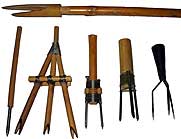 |
 |
The best place to spear fish is obviously where you see fish swimming, duh? And preferably where fish are restricted like in shallow & narrow water and NOT in deep wide bodies of water where they can easily get away from you. When trying to spear fish it's best to be on shore instead of standing in the water to avoid casting your shadow [in the water] which will spook & scare fish away. And when on shore you need to take preferably a kneeling position to reduce casting your shadow in the water and so the fish don't see you on the shoreline too. And then all you gotta do is wait until one comes within spear throwing range, aim slightly "below and forward of the fish" and throw your spear. And here's why, check out the photo. |
The reason why you want to aim "slightly forward" of the fish is to try to counter his quick forward movement when the spear breaks the surface of the water. But this slight forward lead will also depend on the depth of the water, the size and type of fish you're trying to the spear. And the only way you are going to learn how to successfully spear fish is by trial & error or by making some spear fishing targets out of wood like in these in the photo. That's right, they're just cut out pieces of wood in the shape of a fish. Then all you gotta do is drill a few holes along the bottom portion and attach some weight to them so they'll float upwards and you can see'em to practice spearing'em. Pretty good idea, huh? |
 |
 |
Now here's a spear you've probably never seen before, it's my own concoction and it seems to works pretty good too. But to make one you'll need a few large fishing hooks, and so if you've got some spare room in your survival kit, pack three large size fishing hooks. Then all ya gotta do is make a wooden fish spear and attach them about 2-3 inches above the spear point by tying and embedding them into the wood. Then should you miss a fish with the main spear head/point, you got a second chance in "snagging" the fish with one of these hooks. Or if your lucky enough to spear a fish with the main spear point, some of these hooks will help keep the fish on the end of the spear point. If you only have a few medium size fish hooks, they'll work provided you bend out the barbed hooks a bit so they can snag a fish a bit more easier. If there's a lot of grass, weeds & vegetation in the water, be careful or the hooks could get snagged and come off. |
|
There's another way you can catch fish and it's called "snagging." All you have to do is attach one or several fishing hooks to the end of a stick ...
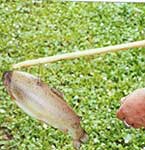 |
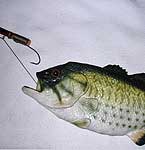 |
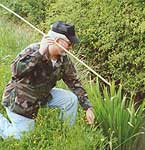 |
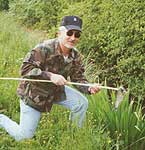 |
..and when a fish is within range you just reach out and snag it up on shore like this. |
If you attach a fish hook to the end of your fishing pole it will help you to pull in your catch. |
But I much prefer to use a spear and wait for some good size tasty fish to pass by and.... |
..if you're patient like me you just might be lucky enough to spear a fish for dinner. |
Have you ever seen one of these before, they're called an Individual Multi-Purpose Survival (IMPS) Net from Brigade Quartermaster.
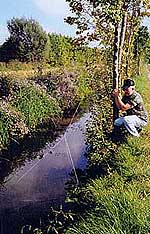 |
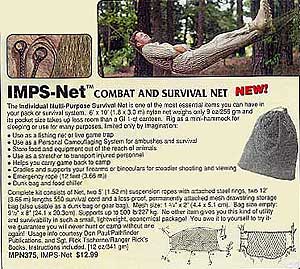 |
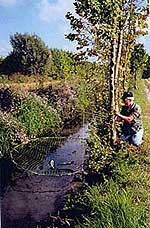 |
When used as a fish net, wait until some good size fish are directly in the center of the net... |
|
..then quickly pull it up. I used my fiberglass tent poles and some 550 para-cord to make this fish net trap. |
Yep, I bought me one of these years ago and I gotta tell ya, they're pretty damn handy. I guarantee you'll find lots of uses for it. And not just for fishing, trust me you will.

|
 |
When I was a kid I really didn't care what kind of fishing pole & reel I owned, I was just happy to go fishing with something other than a tree branch, a safety pin and some string. But guess what? Should you ever need to use any of the fishing gear that comes with all these survival kits a "Tom Sawyer" tree branch is exactly what you're gonna use for a fishing pole.
Now check me out here, look what I caught me. Yep, I caught me a trout with a Tom Sawyer tree branch pole, some paracord nylon thread and a safety pin as a fishing hook. And so here's proof you can catch fish with just a few simple things and you don't need all that high-speed, expensive fishing stuff. |
Well after examining no less than a dozen survival kits from the cheapos to some really expensive ones, they all basically came with the same ol'fishing gear. Though a few of them had some fancy fishing lures, but what good are lures if you don't have a fishing reel, you know? To use a fishing lure you gotta be able to cast out and steadily reel it in at different speeds and depths, right? And so without a fishing reel you really can't use lures without getting'em caught in some underwater weeds, logs and rocks. You know what I mean? |
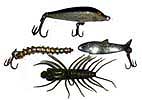 |
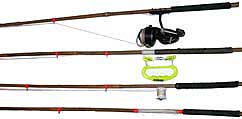 |
Well good ol'Army Ranger Rick has come up with a few good ideas in what you can use as an improvised fishing pole and some reels, check'em out. And the most important items you need for your improvised fishing pole are some small "screw eyelets." Note: The fishing poles you see in the photo are bamboo, and the only reason why I am using bamboo is so you can see more clearly how and where I attached these screw eyelets and my improvised fishing reels. And so if you look very closely at the photos you should be able to figure out how I made these survival fishing kits. |
-
Photo #1 - Shows three (3) types of fishing reels; store purchased, modified sewing spool and kite string reel.
-
Photo #2 - Shows what a package of small screw eyelets look like.
-
Photo #3 - Shows how and where to attach these screw eyelets to make an improvised wooden fishing pole.
-
Photo #4 - Shows a closer look at my plastic sewing spool converted into a small fishing reel.
-
Photo #5 - Shows how you can take a few cheap store purchased fishing reels and attach them to an improvised fishing pole.
-
Phote #6 - Shows how easy it is to place my fishing reel spool inside a 35mm plastic film container with some other fishing items.
-
Photo #7 - Shows how you can convert a 35mm plastic film container into a small compact pocket survival fishing kit.
-
Photo #8 - Shows a closer look at how to convert a kite reel into a fishing reel and kit.
And these photos below show how to make and use a coke can for a fishing reel.
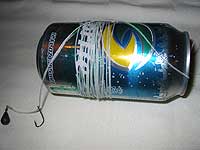 |
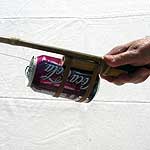 |
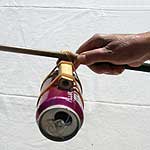 |
A coke can fishing reel that other sites teach ya. |
My coke can "casting" reel position. |
And my coke can "reeling" position. |
And sold separately but only when you order my SOS Survival Kits... my mini "SOS Fishing & Snare Kit!
-
Photo #1 - Shows some of the items that come with my mini fishing & snare kit, screw eyelets, fishing line, assorted hooks, and some snare wire (not shown).
-
Photo #2 - Shows how just a few pieces of red & white chewing gum can be molded into a fishing lure the shape of a minnow, worm, or different types of bugs.
-
Photo #3 - Shows how to make some improvised fishing hooks out of safety pin and how to make larger size hooks from a few small fishing hooks.
-
Photo #4 - Shows how to make different types of fishing lures from some parachute cord, a straw, chewing gum, a rubber band, clothe and some pieces of aluminum.
When I can find them I'll throw in a few small mini minnow fishing hooks too. Why small minnow hooks? For some reason minnows are the least preferred fish to catch and eat in a survival situation. I don't know why when they're not very hard to catch, and believe it or not they are quite tasty too. And if they're less than three inches long you don't have to worry about gutting'em before cooking'em, and you can eat'em raw too. Really!
DID YOU KNOW...here in Italy and in many other countries people eat fried and boiled minnows all the time? Yep, and I'm not talking about just at home but in restaurants and wine & food festivals too? Here's what a fried minnow meal looks like in Italy. So should you someday find yourself in a life or death survival situation and you can't seem to catch any big fish, try catching minnows instead. Or you can catch minnows first, use'em for bait and if you can't catch any big fish with'em, you can always eat the minnows instead. |
 |
Know Your North American Fish
Information Provided by:
Jon Anderson
Where They Live |
What They Eat |
Perch live in lakes and ponds with slightly deeper water; larger perch like depths of 10 to 50 feet.
Perch hang out together in schools, so . . .
Where there is one . . .
there are probably MORE! |
minnows
worms
grasshoppers
crayfish
artificial spinners
jigs |
Brown Trout |
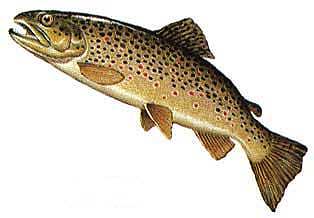
|
Where They Live |
What They Eat |
In Lakes and streams where the water is cool and clean.
They usually hide under a log or the stream bank. they are wary creatures that scare easily. |
worms
grasshoppers / crickets
artificial flies
artificail spinners |
Brook Trout |
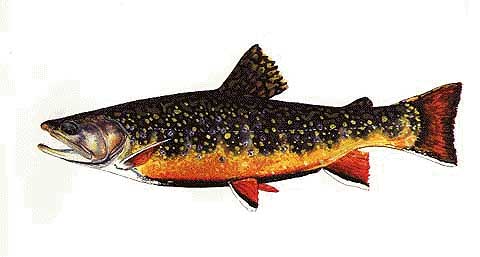 |
Where They Live |
What They Eat |
In Lakes and streams where the water is cool and clean enough for them to survive. They need cooler water than rainbow and brown trout.
these fish are usually small and fairly fragile.
They can be found hiding behind rocks, stick, and logs. You will have to sneak up on them! |
worms
grasshoppers / crickets
salmon eggs
artificial flies
artificail spinners |
Rainbow Trout |
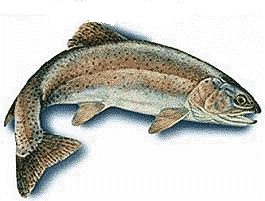 |
Where They Live |
What They Eat |
In Lakes and streams where the water is cool and clean.
In streams they will usually be found near the faster water in the cover of the rocks or logs.
Because of state stocking programs, trout streams will often be matked by signs. |
worms
grasshoppers / crickets
salmon eggs
artificial flies
artificail spinners |
Lake Trout |
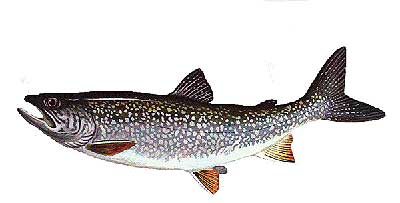
|
Where They Live |
What They Eat |
In the deep water of cold lakes. they may be very deep, so you will probably need LOTS of line on your reel.
In the spring, they spawn (lay eggs) in the shallow water and can be caught with artificial flies. |
artificial spoons
artificial spinners
minnows
artificial flies |
Catfish |
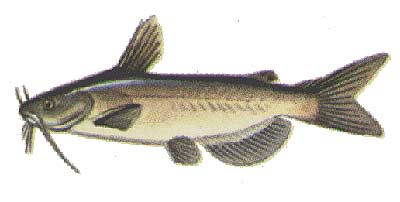 |
Where They Live |
What They Eat |
Prefer really warm, slow water in rivers and lakes. They can be found on the bottom, so a weight and bobber will work great! Catfish like to feed at night so they use a sense of smelland touch to identify thier food.
WARNING: The dorsal and pectoral spines on a catfish carry a toxin that will irritate your hands. Use gloves when removing them from your hook! |
minnows
dough balls
cheese (especially Limburger)
crayfish |
Largemouth Bass |
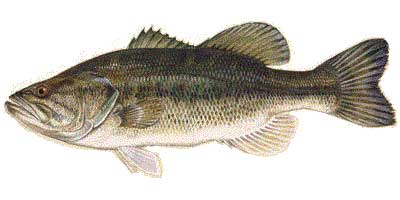 |
Where They Live |
What They Eat |
In lakes with warmer water.Usually found near the shore in weed beds, under lilly pads or around sunken logs, trees and stumps.
These fish are ferocious feeders, so when they take your bait they will give your rod a jolt! |
worms
crayfish
crickets
surface plugs
artificial worms
popping bugs
artificial flies
plastic worms
spinners
bug shiners
and
shiner minnows |
Smallmouth Bass |
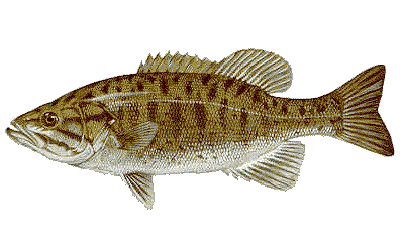 |
Where They Live |
What They Eat |
In streams with water slightly cooler than preferred by their largemouth cousins.
They like to be around rocks and boulders and will chase your bait before they take it, so, be patient! |
worms
crayfish
crickets
minnows
hellgrammites
underwater plugs
artificial spinners
popping bugs
artificial spoons |
Walleye |
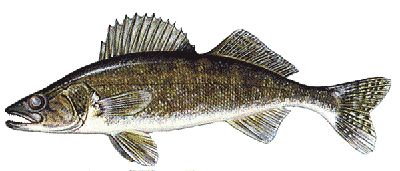 |
Where They Live |
What They Eat |
They live in large lakes with hard, rocky bottoms.
If you can find a place where the edge of the lake drops off into the deep water - drop your line right there at the edge, DEEP! |
minnows
worms
spinners with worms
jigs with worms or minnows |
Muskellunge
or
Muskie |
 |
Where They Live |
What They Eat |
Muskellunge's spend most of their time in the deep water of lakes, but they like to feed in the weeds.
Most muskies are caught while trolling (slowly pulling your lure along) behind a moving boat.
WARNING:
Be very careful removing a Muskellunge from your hook!
Their teeth are very sharp!!! |
minnows
worms
spinners with worms
jigs with worms or minnows |
Northern Pike |

|
|
Where They Live
|
What They Eat
|
|
A Northern Pike can be found in slow-moving streams and the weedy shallows of lakes, under logs and lilly pads and besides stumps. They are aggressive feeders and eat other forms of aquatic life. They even eat small ducks and muskrats.
WARNING:
If you should happen to catch a Pike, be very careful removing it from your hook. It's teeth are very sharp and can cut your hands.
|
minnows
frogs
(real or artificial)
large artificial plugs
(underwater and surface)
big spoons
|
 
Wilderness Survival Skills > Wilderness Survival Tips > Here
Back to top of page
E-MAIL THIS SITE TO A FRIEND
|
|

